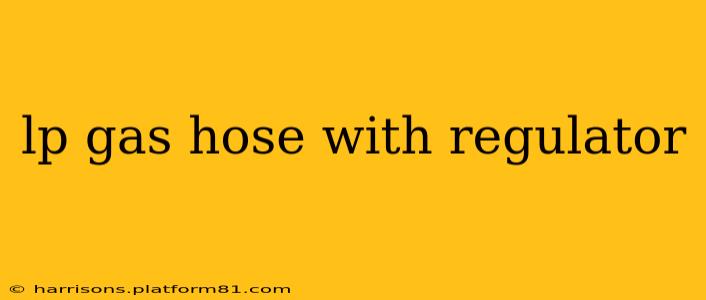Choosing the right LP gas hose with regulator is crucial for the safe and efficient operation of your propane appliances. This guide will delve into the essential aspects of selecting, using, and maintaining these vital components, addressing common concerns and ensuring your safety.
What is an LP Gas Hose with Regulator?
An LP gas hose with regulator is a vital safety device used to connect propane tanks to appliances like grills, stoves, or heaters. The hose itself is designed to withstand the pressure of propane gas, while the regulator reduces the high pressure of the tank to a safe, usable pressure for the appliance. This pressure reduction prevents dangerous pressure buildup and ensures consistent gas flow. The quality of both the hose and regulator is paramount for safety.
What are the Different Types of LP Gas Hoses?
LP gas hoses are typically made from rubber or synthetic materials, designed to be resistant to propane and the elements. Key factors to consider include:
- Length: Choose a hose length appropriate for your setup; too short, and you risk strain on the connection; too long, and you increase the risk of tripping or damage.
- Material: Rubber hoses are common, but synthetic materials offer improved durability and resistance to cracking and weathering.
- Construction: Look for reinforced hoses with multiple layers for added strength and protection against punctures.
- Fittings: Ensure the hose fittings are compatible with both your propane tank and your appliance. Common fittings include 1/4" NPT (National Pipe Thread) and 1/4" SAE (Society of Automotive Engineers).
How Do I Choose the Right Regulator for My LP Gas Hose?
The regulator is the heart of the system, reducing the high tank pressure to the low pressure your appliance needs. Critical considerations include:
- Pressure Rating: Check the pressure rating of your appliance and select a regulator that matches or exceeds it. This is critical for safe operation.
- Flow Rate: The flow rate should be sufficient for your appliance's needs. A regulator with a higher flow rate will accommodate larger appliances or higher gas consumption.
- Type: Two-stage regulators offer more precise pressure regulation than single-stage regulators, leading to a more consistent gas supply.
- Materials: Durable materials resistant to corrosion and wear are essential for long-lasting performance.
What are the Safety Precautions When Using an LP Gas Hose with Regulator?
Safety is paramount when handling propane. Here are some crucial safety precautions:
- Regular Inspection: Regularly check the hose and regulator for signs of damage, such as cracks, leaks, or corrosion. Replace any damaged components immediately.
- Leak Detection: Use a soapy water solution to check for leaks around the connections. Bubbles indicate a leak, requiring immediate attention.
- Proper Storage: Store your propane tank and hose in a well-ventilated area, away from ignition sources.
- Ventilation: Ensure adequate ventilation around the appliance to prevent the buildup of propane gas.
- Professional Installation: If you're not comfortable installing the hose and regulator yourself, consult a qualified professional.
How Often Should I Replace My LP Gas Hose and Regulator?
The lifespan of an LP gas hose and regulator varies depending on usage and environmental conditions. However, it's generally recommended to replace the hose every 3-5 years, or sooner if you notice any signs of wear or damage. Regulators should also be replaced every few years, following manufacturer recommendations.
What are the Signs of a Failing LP Gas Hose or Regulator?
Several signs can indicate a failing hose or regulator:
- Cracks or cuts in the hose.
- Leaks around the connections.
- Inconsistent gas flow.
- Unusual noises coming from the regulator.
- A noticeable drop in appliance performance.
Can I Repair a Damaged LP Gas Hose or Regulator?
No. Do not attempt to repair a damaged LP gas hose or regulator. These components are critical for safety, and any repair attempt can compromise safety and lead to dangerous situations. Always replace damaged components with new ones.
Where Can I Buy an LP Gas Hose with Regulator?
LP gas hoses and regulators are available at various retailers, including home improvement stores, hardware stores, and online retailers. Ensure you purchase from a reputable source that sells high-quality products.
By following these guidelines, you can ensure that your LP gas system is safe and efficient. Remember, safety should always be your top priority when dealing with propane gas. Always refer to the manufacturer's instructions for specific details on your equipment.
